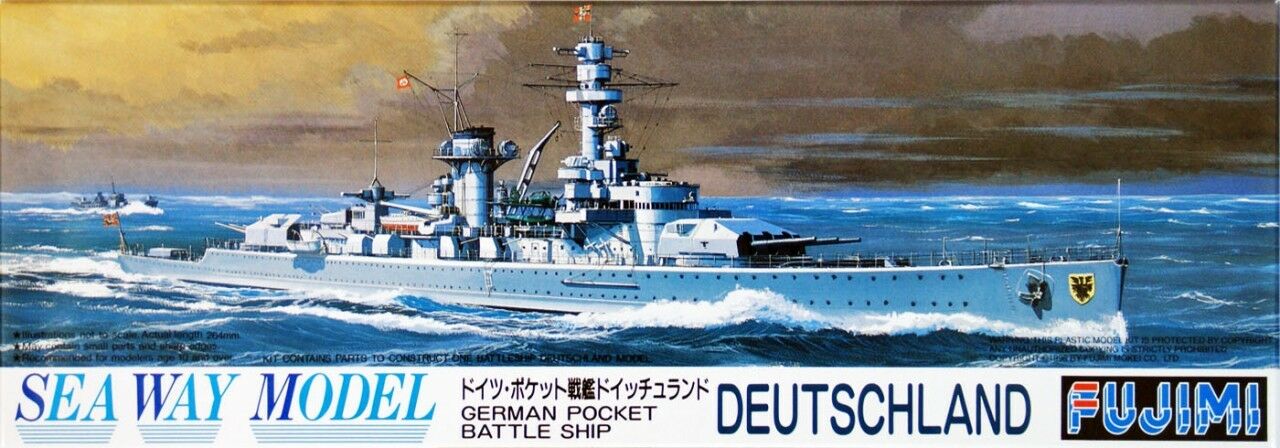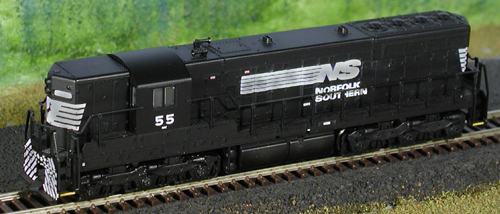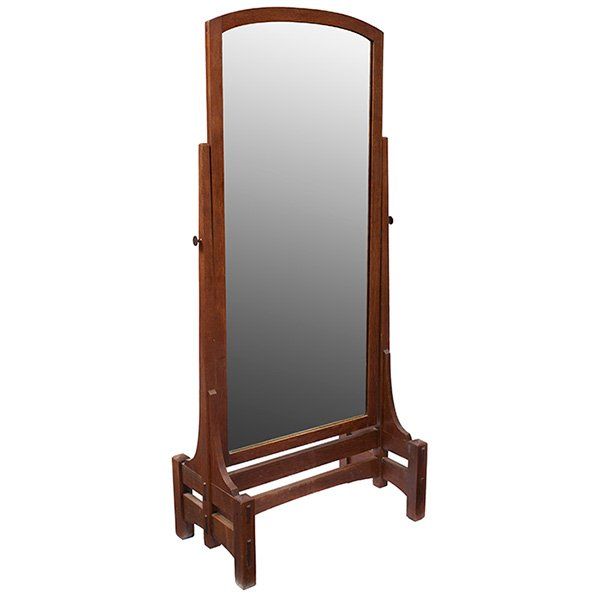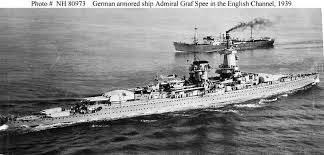Class: The Deutschland class was a series of three Panzerschiffe ("armored ships"), a form of heavily armed cruiser, built by the Reichsmarine officially in accordance with restrictions imposed by the Treaty of Versailles. The class, which comprised the ships Deutschland, Admiral Scheer, and Admiral Graf Spee, were all stated to displace 10,000 long tons (10,000 t) in accordance with the Treaty, though they actually displaced 10,600 to 12,340 long tons (10,770 to 12,540 t) at standard displacement. Despite violating the weight limitation, the design for the ships incorporated several radical innovations to save weight. They were the first major warships to use welding and all-diesel propulsion. Due to their heavy armament of six 28 cm (11 in) guns, the British began referring to the vessels as "pocket battleships". The Deutschland class ships were initially classified as Panzerschiffe or "armored ships", but the Kriegsmarine reclassified them as heavy cruisers in February 1940.
The three ships were built between 1929 and 1936 by the Deutsche Werke and Reichsmarinewerft in Kiel and Wilhelmshaven, respectively. They saw heavy service with the German Navy. All three vessels served on non-intervention patrols during the Spanish Civil War. While on patrol, Deutschland was attacked by Republican bombers, and in response, Admiral Scheer bombarded the port of Almería. In 1937, Admiral Graf Spee represented Germany at the Coronation Review for Britain's King George VI. For the rest of their peacetime careers, the ships conducted a series of fleet maneuvers in the Atlantic and visited numerous foreign ports in goodwill tours.
Before the outbreak of World War II, Deutschland and Admiral Graf Spee were deployed to the Atlantic to put them in position to attack Allied merchant traffic once war was declared. Admiral Scheer remained in port for periodic maintenance. Deutschland was not particularly successful on her raiding sortie, during which she sank or captured three ships. She then returned to Germany where she was renamed Lützow. Admiral Graf Spee sank nine vessels in the South Atlantic before she was confronted by three British cruisers at the Battle of the River Plate. Although she damaged the British ships severely, she was herself damaged and her engines were in poor condition. Coupled with false reports of British reinforcements, the state of the ship convinced Hans Langsdorff, her commander, to scuttle the ship outside Montevideo.
Lützow and Admiral Scheer were deployed to Norway in 1942 to join the attacks on Allied convoys to the Soviet Union. Admiral Scheer conducted Operation Wunderland in August 1942, a sortie into the Kara Sea to attack Soviet merchant shipping, though it ended without significant success. Lützow participated in the Battle of the Barents Sea in December 1942, a failed attempt to destroy a convoy. Both ships were damaged in the course of their deployment to Norway, and eventually returned to Germany for repairs. They ended their careers bombarding advancing Soviet forces on the Eastern Front; both ships were destroyed by British bombers in the final weeks of the war. Lützow was raised and sunk as a target by the Soviet Navy while Admiral Scheer was partially broken up in situ, with the remainder of the hulk buried beneath rubble
The three ships were built between 1929 and 1936 by the Deutsche Werke and Reichsmarinewerft in Kiel and Wilhelmshaven, respectively. They saw heavy service with the German Navy. All three vessels served on non-intervention patrols during the Spanish Civil War. While on patrol, Deutschland was attacked by Republican bombers, and in response, Admiral Scheer bombarded the port of Almería. In 1937, Admiral Graf Spee represented Germany at the Coronation Review for Britain's King George VI. For the rest of their peacetime careers, the ships conducted a series of fleet maneuvers in the Atlantic and visited numerous foreign ports in goodwill tours.
Before the outbreak of World War II, Deutschland and Admiral Graf Spee were deployed to the Atlantic to put them in position to attack Allied merchant traffic once war was declared. Admiral Scheer remained in port for periodic maintenance. Deutschland was not particularly successful on her raiding sortie, during which she sank or captured three ships. She then returned to Germany where she was renamed Lützow. Admiral Graf Spee sank nine vessels in the South Atlantic before she was confronted by three British cruisers at the Battle of the River Plate. Although she damaged the British ships severely, she was herself damaged and her engines were in poor condition. Coupled with false reports of British reinforcements, the state of the ship convinced Hans Langsdorff, her commander, to scuttle the ship outside Montevideo.
Lützow and Admiral Scheer were deployed to Norway in 1942 to join the attacks on Allied convoys to the Soviet Union. Admiral Scheer conducted Operation Wunderland in August 1942, a sortie into the Kara Sea to attack Soviet merchant shipping, though it ended without significant success. Lützow participated in the Battle of the Barents Sea in December 1942, a failed attempt to destroy a convoy. Both ships were damaged in the course of their deployment to Norway, and eventually returned to Germany for repairs. They ended their careers bombarding advancing Soviet forces on the Eastern Front; both ships were destroyed by British bombers in the final weeks of the war. Lützow was raised and sunk as a target by the Soviet Navy while Admiral Scheer was partially broken up in situ, with the remainder of the hulk buried beneath rubble
Warship: Deutschland was the lead ship of her class of heavy cruisers (often termed a pocket battleship) which served with the Kriegsmarine of Nazi Germany during World War II. Ordered by the Weimar government for the Reichsmarine, she was laid down at the Deutsche Werke shipyard in Kiel in February 1929 and completed by April 1933. Originally classified as an armored ship (Panzerschiff) by the Reichsmarine, in February 1940 the Germans reclassified the remaining two ships of this class as heavy cruisers.[a] In 1940, she was renamed Lützow, after the Admiral Hipper-class heavy cruiser Lützow was handed over to the Soviet Union.
The ship saw significant action with the Kriegsmarine, including several non-intervention patrols in the Spanish Civil War, during which she was attacked by Republican bombers. At the outbreak of World War II, she was cruising the North Atlantic, prepared to attack Allied merchant traffic. Bad weather hampered her efforts, and she sank or captured only a handful of vessels before returning to Germany. She then participated in Operation Weserübung, the invasion of Norway. Damaged at the Battle of Drøbak Sound, she was recalled to Germany for repairs. While en route, she was torpedoed and seriously damaged by a British submarine.
Repairs were completed by March 1941, Lützow returned to Norway to join the forces arrayed against Allied shipping to the Soviet Union. She ran aground during a planned attack on convoy PQ 17, which necessitated another return to Germany for repairs. She next saw action at the Battle of the Barents Sea with the heavy cruiser Admiral Hipper, which ended with a failure to destroy the convoy JW 51B. Engine problems forced a series of repairs culminating in a complete overhaul at the end of 1943, after which the ship remained in the Baltic. Sunk in shallow waters in the Kaiserfahrt in April 1945 by Royal Air Force (RAF) bombers, Lützow was used as a gun battery to support German troops fighting the Soviet Army until 4 May 1945, when she was disabled by her crew. Raised by the Soviet Navy in 1947, she was subsequently sunk as a target in the Baltic.
The ship saw significant action with the Kriegsmarine, including several non-intervention patrols in the Spanish Civil War, during which she was attacked by Republican bombers. At the outbreak of World War II, she was cruising the North Atlantic, prepared to attack Allied merchant traffic. Bad weather hampered her efforts, and she sank or captured only a handful of vessels before returning to Germany. She then participated in Operation Weserübung, the invasion of Norway. Damaged at the Battle of Drøbak Sound, she was recalled to Germany for repairs. While en route, she was torpedoed and seriously damaged by a British submarine.
Repairs were completed by March 1941, Lützow returned to Norway to join the forces arrayed against Allied shipping to the Soviet Union. She ran aground during a planned attack on convoy PQ 17, which necessitated another return to Germany for repairs. She next saw action at the Battle of the Barents Sea with the heavy cruiser Admiral Hipper, which ended with a failure to destroy the convoy JW 51B. Engine problems forced a series of repairs culminating in a complete overhaul at the end of 1943, after which the ship remained in the Baltic. Sunk in shallow waters in the Kaiserfahrt in April 1945 by Royal Air Force (RAF) bombers, Lützow was used as a gun battery to support German troops fighting the Soviet Army until 4 May 1945, when she was disabled by her crew. Raised by the Soviet Navy in 1947, she was subsequently sunk as a target in the Baltic.
Brand: Fujimi Mokei Co., Ltd. (フジミ模型株式会社 Fujimi Mokei Kabushiki Gaisha) is a Japanese model manufacturer based in Shizuoka Prefecture. It produces plastic model kits of a variety of vehicles, including model aircraft, model cars, model ships and model armored vehicles along with historical structures and science fiction kits. Since "mokei" means "model" in Japanese, "Fujimi Mokei" is often called "Fujimi Model(s)" in English.
Item created by: gdm on 2019-07-31 12:42:13. Last edited by gdm on 2019-07-31 12:42:54
If you see errors or missing data in this entry, please feel free to log in and edit it. Anyone with a Gmail account can log in instantly.
If you see errors or missing data in this entry, please feel free to log in and edit it. Anyone with a Gmail account can log in instantly.










